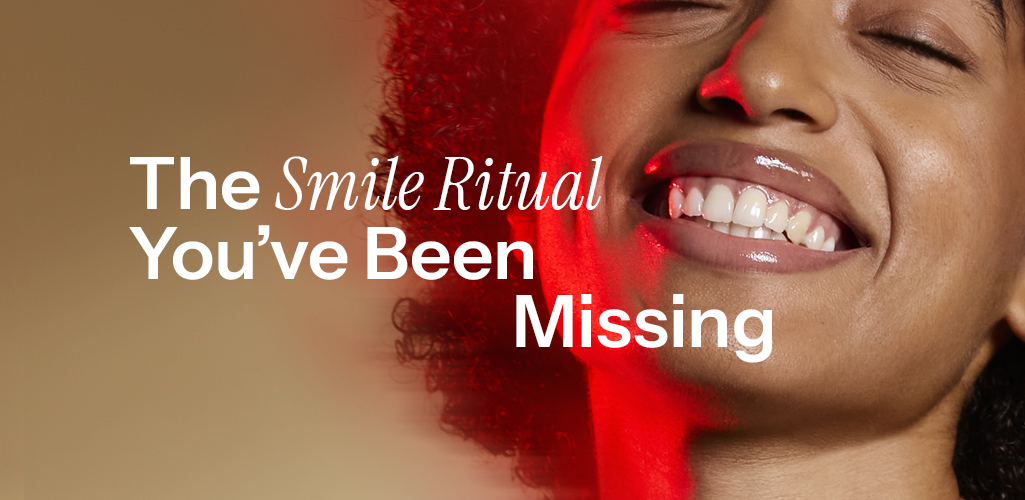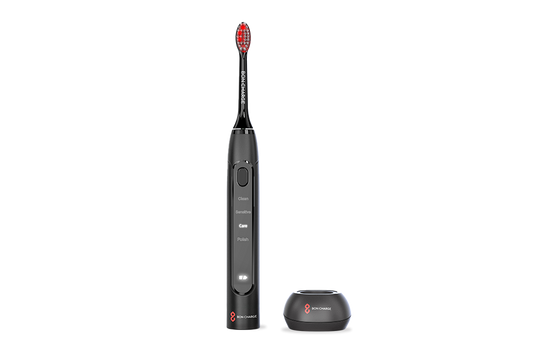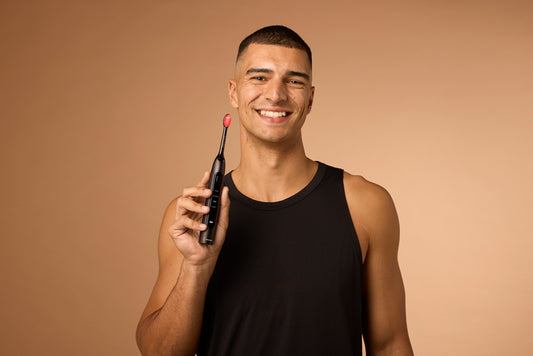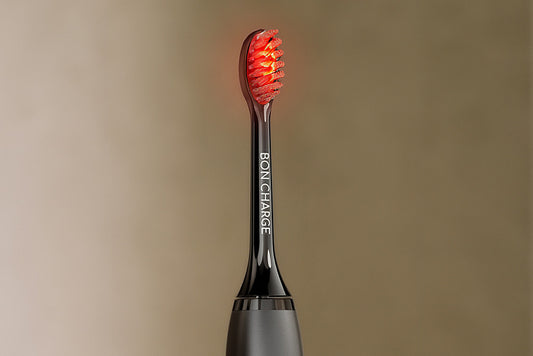The Light Your Smile Has Been Missing
Ana Martins, PhD
Why does that matter?
Because the periodontal tissues, the gums, connective tissue and supporting structures around the teeth, are metabolically active, vascular and responsive to light. Emerging research suggests that specific red (≈630–660 nm) and near-infrared (≈800–850 nm) wavelengths may help support gingival cells, modulate inflammatory responses and maintain a healthier oral environment.1–5
In other words, your daily brushing ritual may have been doing the mechanical work, but it may not have been doing the mitochondrial work.
According to leading biological dentist and Scientific Advisor, Dr. Sebastien Lomas (known as Dr Seb) red and near-infrared light have a profound influence on the cellular environment within the mouth.
“These wavelengths interact directly with the mitochondria, the energy centres of our cells, stimulating ATP production and enhancing cellular repair,” he explains. “Clinically, we see this manifest as improved microcirculation, healthier cellular responses, reduced inflammation, and accelerated tissue healing, particularly in the gums and mucosa. The light essentially ‘switches on’ the body’s innate regenerative capacity, supporting everything from post-surgical recovery to periodontal health.”
How Photobiomodulation Applies to the Mouth
Red and near-infrared light therapies sit under what’s widely termed photobiomodulation (PBM) - the use of non-thermal, low-level light to trigger beneficial biological responses.2,3
At a cellular level, several mechanisms have been investigated:
- Mitochondrial activation. Chromophores within the mitochondria, particularly cytochrome c oxidase (CCO), can absorb red and near-infrared photons. This can improve electron transport chain efficiency and increase ATP synthesis, giving cells more energy for repair, turnover and homeostasis.2
- Nitric oxide (NO) modulation. Light exposure may help displace nitric oxide bound to CCO, supporting mitochondrial respiration while also increasing local NO availability, which is associated with microcirculatory benefits and vasodilation.13–15
- Inflammation signalling. PBM has been shown to down-regulate pro-inflammatory cytokines and support a more balanced inflammatory response in oral cells, which has significant impact on where gums are mildly irritated or undergoing everyday stress.1,4,7,8
- Cell proliferation and matrix support. Gingival fibroblasts, key for maintaining the structure of gum tissue have demonstrated improved viability and modulation of regenerative markers when exposed to these wavelengths.1,18
When you apply that science to the oral cavity, the proposition is simplified and able to be applied in practice. By energising the gingival cells, supporting microcirculation and stimulating healthy cellular responses, we may be able to better support the tissues that hold the smile together.
Dr Seb describes light therapy as a “beautiful habit stack” to conventional oral hygiene.
“While brushing and flossing remove bacterial biofilm mechanically, red light supports the biological terrain, modulating inflammation, enhancing oxygenation, and helping to rebalance the oral microbiome at a cellular level,” he says. “It doesn’t just clean; it helps the tissues themselves function more optimally. Used consistently, light-based oral care can help support healthy gums, soothe sensitivity, and improve wound healing after dental treatment.”
One Smile, Two Wavelengths
The mouth isn’t a flat, uniform surface. It consists of multiple layers, in the same way that our skin does also. The epithelium, connective tissue, vasculature and each layer has different light-absorption and scattering characteristics.
That’s why using both red and near-infrared together can have such an impact.
Red Light (≈630 - 660 nm): Surface-Directed, Symptom-Adjacent
Red light is largely absorbed in the more superficial oral tissues. That makes it well suited to areas where irritation, occasional sensitivity and plaque-related gingival stress commonly appear.
Red light may help to:
- Support gingival tissue health between professional hygienist cleans.11
- Improve cellular energy availability for maintenance and recovery.9
- Modulate inflammatory responses in irritated gingival fibroblasts, helping to calm the area.4,7,8
This is not a mask for poor hygiene or a replacement for periodontal care, but rather the support for the tissue that gets challenged daily.
Near-Infrared Light (≈800 - 850 nm): Deeper, Foundational Support
Near-infrared is not visible, but it penetrates more deeply into soft tissue.12 This deeper reach makes it relevant for supporting sub-gingival tissues and areas where improved perfusion is beneficial.
Near-infrared may help to:
- Stimulate local circulation and microvascular activity, which is important for nutrient delivery and waste removal.13–15
- Support deeper cellular activity in tissues that can’t be reached by visible light alone.1,16
- Encourage longer-term vitality of oral tissues when used consistently.17
Used together, these wavelengths can offer a dual-layer approach. Achieving surface-level calm, deeper-level activation, without adding an onerous step to the routine.18
Why the Gums Deserve the Spotlight
Most people think of oral care as “teeth”, but teeth are only as stable as the tissue that holds them.
Gums sit at the crossroads of multiple stressors:
- Mechanical (brushing too hard, clenching)
- Microbial (shifts in oral microbiota, biofilm load)
- Systemic (blood sugar fluctuations, sleep, mouth breathing)
- Lifestyle (dietary acids, low saliva, stress)
When gum tissue is under repeated stress, we often see:
- Intermittent sensitivity
- Mild redness or irritation
- A feeling of “tight” or reactive gums
This is where light-assisted oral care becomes interesting.
Light and the Oral Microbiome
A key area of emerging interest is the oral microbiome, the highly dynamic community of bacteria and other microorganisms that live in the mouth. Dysbiosis here has been linked to periodontal challenges and even systemic consequences.19
Narrative reviews suggest that visible red and near-infrared wavelengths may help maintain a more balanced oral environment by supporting host tissue resilience and, in some contexts, exerting mild, non-disruptive antimicrobial effects.5,11 This isn’t about sterilising the mouth, which we don’t want, it’s about supporting a healthier ecosystem at the gingival margin.
Because the mouth is the first segment of the digestive tract, supporting oral tissue isn’t just cosmetic, it’s preventive wellness.
A Familiar Technology, in a New Place
Red light is not experimental. It’s been used for decades in dermatology, sports recovery, and rehabilitation to support tissue repair and reduce perception of discomfort.20,21 What’s evolving now is the application of the same well-characterised wavelengths to targeted oral use and early data is encouraging.
What makes it especially compelling for a brand like BON CHARGE™ is that light can be embedded into an existing ritual, brushing, so there’s no behaviour change tax. No 20-minute extra session. No separate device to remember. Just light at the exact moment the gums are already being stimulated.
No added time. More biological value per minute.
Why Smiles Deserve More Than “Clean Teeth”
Most self-care categories have matured - sleep, skin, recovery. Oral care is only just catching up. A future-focused oral routine should consider:
- Mechanical hygiene (brush, floss, professional cleans)
- Biological support (supporting the tissue, not just the tooth)
- Microbiome harmony (supporting the terrain)
- Circulatory and mitochondrial wellness in oral tissues
Integrating Light Into Daily Oral Care
Here’s how to frame it for customers or practitioners:
- Light is complementary, not curative - may support tissues between dental appointments.
- Consistency matters benefits are often cumulative - think daily, low-dose exposure rather than occasional intense use.
- Contraindications and clinical care come first - anyone with an active oral condition, implants, or who is undergoing treatment should check with a dental or medical professional before adding light.
- Quality of wavelength matters - red and near-infrared should be in the ranges supported by the literature, which is why device engineering and LED quality are not trivial.
For Dr Seb, the true promise of light therapy lies in its ability to bridge traditional oral care with systemic wellness.
“Light therapy embodies the ‘supporting systemic wellness through oral balance’ philosophy we hold dear,” he adds. “I believe we’ll see it integrated into both at-home routines and clinical protocols, not as a gimmick, but as an evidence-backed regenerative modality. What excites me most is its accessibility: empowering patients to take an active role in their healing, using light as a non-invasive, natural means to support vitality and longevity through oral health.”
What’s Next
At BON CHARGE™, we’ve always asked: where else should light live? We’ve brought it to the face, the body, and even to sleep routines, and now, to the mouth. The BON CHARGE™ Red Light Toothbrush introduces light to one of the most overlooked parts of wellness: the gums. Using dual wavelengths of red and near-infrared light, it’s engineered specifically for the oral environment, designed to support gum vitality and cellular balance with precision. It integrates seamlessly into the few minutes you already spend brushing, transforming a daily habit into a moment of science-backed renewal and it’s grounded in compliance-minded wellness education, ensuring that innovation and integrity remain aligned in every detail.
Because the smile is not just aesthetic, it’s a biomarker of systemic wellbeing. And it deserves tools that match that level of importance.
References
- Kocherova, I. et al. Photobiomodulation with Red and Near-Infrared Light Improves Viability and Modulates Expression of Mesenchymal and Apoptotic-Related Markers in Human Gingival Fibroblasts. Mater. Basel Switz. 14, 3427 (2021).
- Hamblin, M. R. & Demidova, T. N. Mechanisms of low level light therapy. in Mechanisms for Low-Light Therapy vol. 6140 614001 (SPIE, 2006).
- Hamblin, M. R. Mechanisms and applications of the anti-inflammatory effects of photobiomodulation. AIMS Biophys. 4, 337–361 (2017).
- Yamauchi, N. et al. High-Intensity Red Light-Emitting Diode Irradiation Suppresses the Inflammatory Response of Human Periodontal Ligament Stem Cells by Promoting Intracellular ATP Synthesis. Life Basel Switz. 12, 736 (2022).
- Amaroli, A., Ravera, S., Zekiy, A., Benedicenti, S. & Pasquale, C. A Narrative Review on Oral and Periodontal Bacteria Microbiota Photobiomodulation, through Visible and Near-Infrared Light: From the Origins to Modern Therapies. Int. J. Mol. Sci. 23, 1372 (2022).
- Genina, E. A. et al. Phototherapy of gingivitis: pilot clinical study. J. Innov. Opt. Health Sci. 04, 437–446 (2011).
- Lim, W. et al. Anti-inflammatory effect of 635 nm irradiations on in vitro direct/indirect irradiation model. J. Oral Pathol. Med. 44, 94–102 (2015).
- Choi, H. et al. Inflammatory cytokines are suppressed by light-emitting diode irradiation of P. gingivalis LPS-treated human gingival fibroblasts. Lasers Med. Sci. 27, 459–467 (2012).
- Yoo, K.-M. et al. Development of LED Module for Tooth Care with Effect of Promoting Scar Treatment and Analysis of Optical Properties. J. Korean Soc. Ind. Converg. 23, 701–708 (2020).
- Anitasari, S., Wahab, D. E., Barlianta, B. & Budi, H. S. Determining the Effectivity of Infrared Distance to Eliminate Dental Pain Due to Pulpitis and Periodontitis. Eur. J. Dent. 14, 360–365 (2020).
- Lee, J. et al. In vitro investigation of the antibacterial and anti-inflammatory effects of LED irradiation. J. Periodontal Implant Sci. 53, 110–119 (2023).
- Ash, C., Dubec, M., Donne, K. & Bashford, T. Effect of wavelength and beam width on penetration in light-tissue interaction using computational methods. Lasers Med. Sci. 32, 1909–1918 (2017).
- Keszler, A. et al. In Vivo Characterization of a Red Light-Activated Vasodilation: A Photobiomodulation Study. Front. Physiol. 13, 880158 (2022).
- Mitchell, U. H. & Mack, G. L. Low-level laser treatment with near-infrared light increases venous nitric oxide levels acutely: a single-blind, randomized clinical trial of efficacy. Am. J. Phys. Med. Rehabil. 92, 151–156 (2013).
- George, S., Hamblin, M. R. & Abrahamse, H. Effect of red light and near infrared laser on the generation of reactive oxygen species in primary dermal fibroblasts. J. Photochem. Photobiol. B 188, 60–68 (2018).
- Desmet, K. D. et al. Clinical and experimental applications of NIR-LED photobiomodulation. Photomed. Laser Surg. 24, 121–128 (2006).
- Barolet, D. Photobiomodulation in Dermatology: Harnessing Light from Visible to Near Infrared. Med. Res. Arch. 6, (2018).
- Etemadi, A., Sadatmansouri, S., Sodeif, F., Jalalishirazi, F. & Chiniforush, N. Photobiomodulation Effect of Different Diode Wavelengths on the Proliferation of Human Gingival Fibroblast Cells. Photochem. Photobiol. 97, 1123–1128 (2021).
- Van Dyke, T. E., Bartold, P. M. & Reynolds, E. C. The Nexus Between Periodontal Inflammation and Dysbiosis. Front. Immunol. 11, (2020).
- Glass, G. E. Photobiomodulation: The Clinical Applications of Low-Level Light Therapy. Aesthet. Surg. J. 41, 723–738 (2021).
- Leal-Junior, E. C. P. et al. Effect of phototherapy (low-level laser therapy and light-emitting diode therapy) on exercise performance and markers of exercise recovery: a systematic review with meta-analysis. Lasers Med. Sci. 30, 925–939 (2015).







